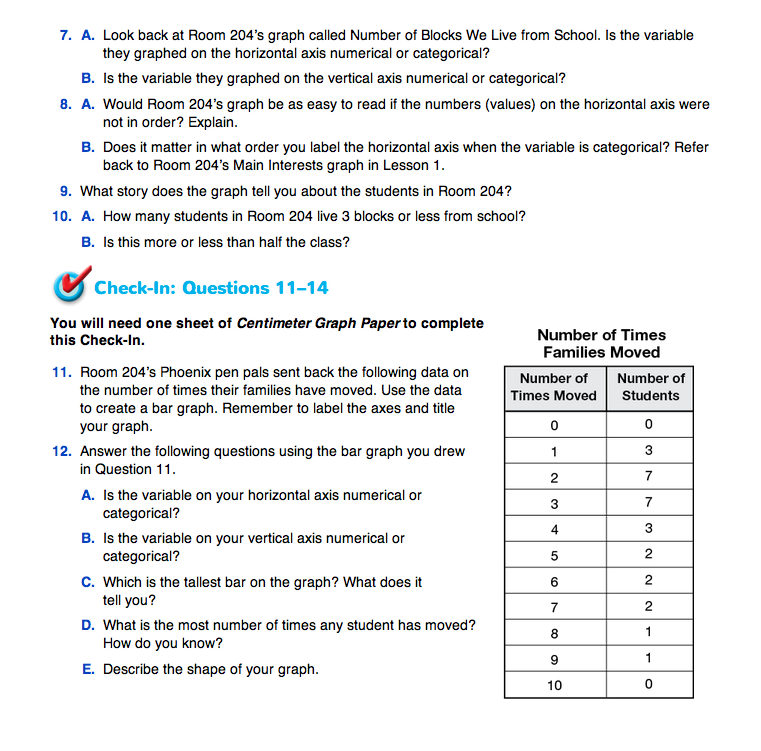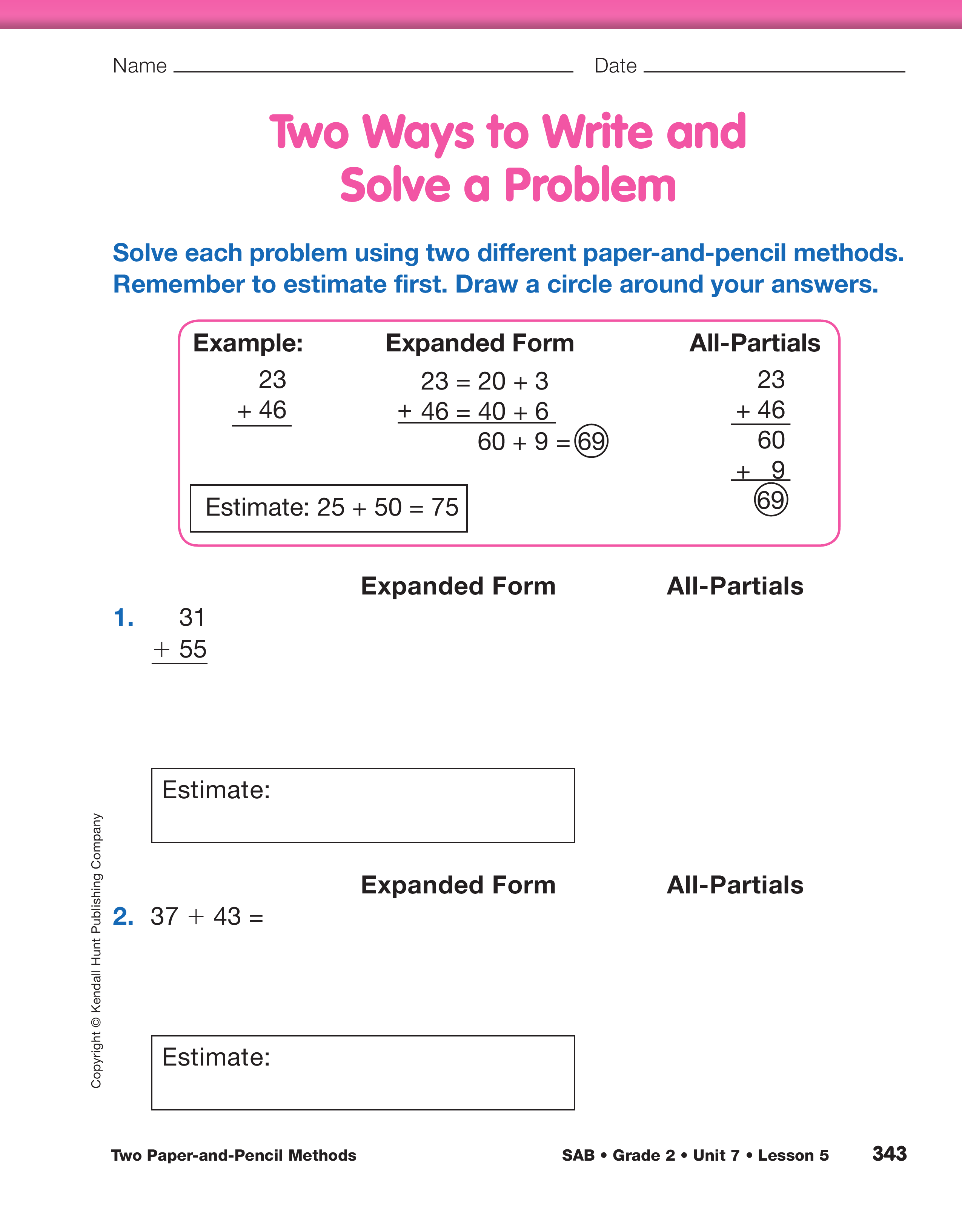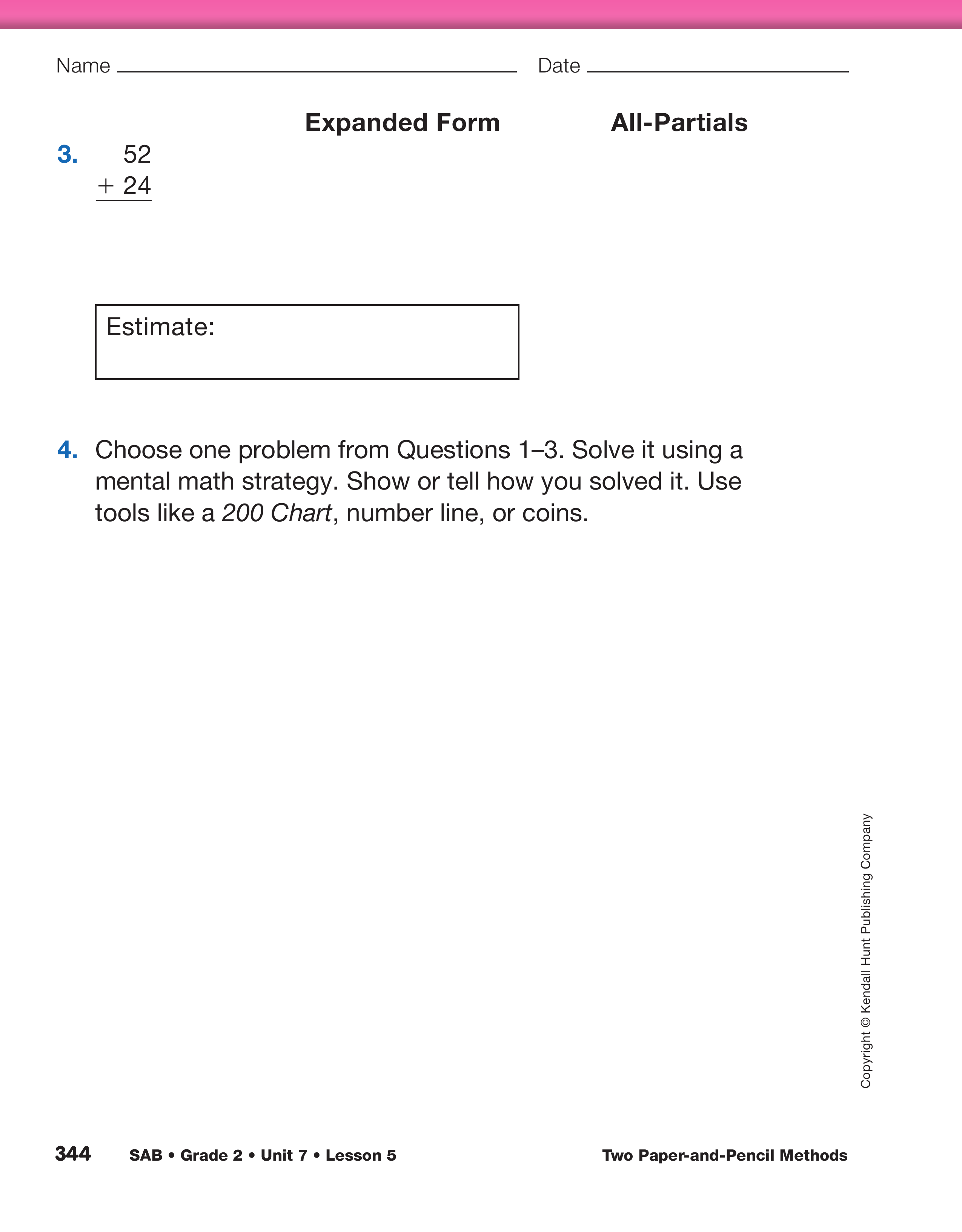Review the expanded form method of solving addition
problems discussed in Part 1. Tell students it is
just one of several different ways to solve a problem
using paper and pencil. Now they will learn another
way. Display the following problem and have
students model it using their base-ten pieces.
- Explain how you would estimate the sum to this problem. (If I look at the tens, 3 tens plus 2 tens is 5 tens or 50. And 8 ones and 6 ones makes another ten, so I think it is about 60.)
Then tell students that a girl named Janette used a paper-and-pencil method to solve it. Display the completed problem:
Give student pairs a few minutes to discuss with their partners what they think Janette did to solve the problem.
- What were Janette´s steps and how did she record them?
- Why did Janette write the 50 just below the firstline? What was she thinking? (She added the
3 + 2, which is really 30 + 20.)
- How did she know that 3 + 2 is really 30 + 20? (Because they are in the tens place. Three means three tens; 2 means two tens. When you add them, it is five tens, or 50.)
- What is that with your base-ten pieces? (3 skinnies and 2 skinnies are 5 skinnies, which is five tens, 50.)
- What does the 14 mean? Why did Janette write 14? (She added 8 + 6 and got 14.)
- Are 8 and 6 also tens? Why or why not? (They are ones because they are in the ones place. So 8 ones and 6 ones is 14 ones.)
- Show 14 ones with base-ten pieces. (14 bits)
- Why did Janette write 64 as her answer? (She added 50 plus 14.)
- What base-ten pieces show 5 tens and 14 ones? (5 skinnies and 14 bits.)
- What is a number sentence that describes your pieces? (50 + 14 = 64)
Write 50 + 14 = 60 + 4 on the board and ask:
- Is this a true number sentence: 50 + 14 = 60 + 4? Why or why not? (Possible response: Yes, it is a true number sentence because 50 + 14 is 64 and 60 + 4 is 64. Both sides of the equation show the same amount.)
Pose the next questions and write the number sentences on the board. Ask students to look at their base-ten pieces to answer if they need to.
- Is this a true number sentence: 38 + 26 = 50 + 14? Why or why not? (Possible response: Yes, it is a true number sentence. 3 tens plus 2 tens is 5 tens. 8 ones plus 6 ones is 1 ten and 4 ones. 5 tens plus 1 ten plus 4 ones is 64, just like 50 + 14 is 64.)
- Is this a true number sentence: 38 + 26 = 60 + 4? Why or why not? (Possible response: Yes; both sides of the equation show 64.)
Give the students similar problems such as 63 + 18 and ask them to solve them using the all-partials method.
Remind them to first estimate the sum. Tell students they can use their base-ten pieces to model the problems.
Starting on the Right or the Left. For both the expanded form and the all-partials method of addition,
it doesn´t matter whether a student starts on the left or the right. In either method, a student may choose to add
the tens before the ones or vice versa with no loss of efficiency or accuracy. Students may be inclined to start
on the left, since they are learning to read from left to right. They should order the steps that feel most
comfortable to them.
Remind students to think about adding tens and about adding ones, as they do with base-ten pieces, and then
combining these partial sums to find the sum.
Discuss the solution. Some students may solve the problem as follows, adding from left to right and adding the
ones first:
Make a point of demonstrating that, just like when adding with base-ten pieces, you can either add the tens or the ones first. See Content Note.
Demonstrate the same problem adding the tens first:
- Does it matter if you add the tens or the ones first? How do you know? (No, the order doesn´t matter. You can add the tens or the ones first and you will get the same answer.)
- Why do you think this paper-and-pencil method is called the all-partials method? (Possible response: Partial means part. Each step gives you part of the total sum.)
Give the students a few more problems to solve using the all-partials method.
After each problem, have a similar discussion about the components of the
solution path. Help students make connections between the base-ten pieces, the place
value of the numbers, and the steps of the all-partials method.
Have students complete the Two Ways to Write and Solve a Problem pages in the Student Activity Book.
















